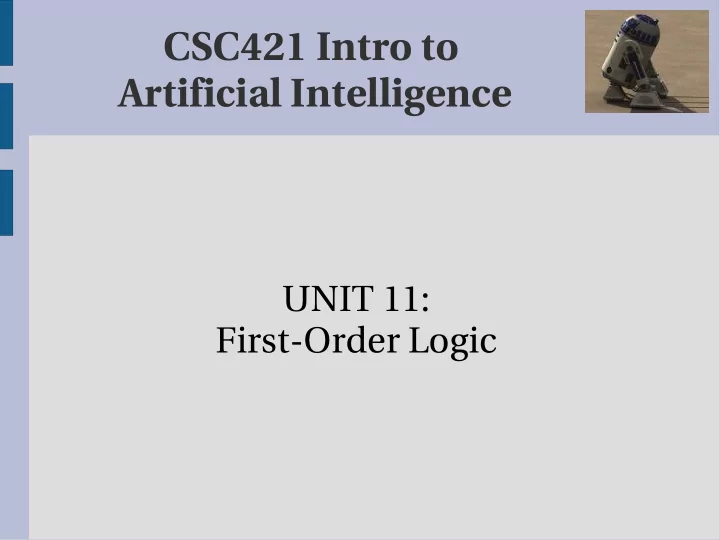

CSC421 Intro to Artificial Intelligence UNIT 11: First-Order Logic
Assignment discussion ● What was the biggest challenge ? ● What did you learn doing it ? ● How could it be improved ? ● What did you hate about the assignment ? ● Was it related to what we covered in class ? ● Other questions ?
Models for FOL example
Talking about collections of objects ● Variables x, y, z ● Quantifiers – Universal ∀ – Existential ∃ ● Expressing concisely – All kings are persons – Squares neighboring the wumpus are smelly – There is a piece of gold somewhere in the world
Universal Quantifier ● ∀ <variables> <sentence> ● Everyone at CSC421 is smart – ∀ x In(x, CSC421) => Smart(x) – ∀ x P is true in model m iff P is true with x being each possible object in the model – Roughly speaking equivalent to the conjuctions of instantiations of P – (In(Adam, CSC421)=>Smart(Adam)) ∧ (In(Neesha, CSC421)=>Smart(Adam)) ∧ (In(CSC421, CSC421) => Smart(CSC421)) ∧ . . . .
Existential Quantification ● ∃ <variables> <sentence> ● Someone at UVic is smart – ∃ x At(x, UVic) ∧ Smart(x) – ∃ x P is true in a model m iff P is true with x being some possible object in the model – Roughly speaking, equivalent to the disjunction of instantiations of P – (At(Adam, CSC421) ∧ Smart(Adam)) ∨ (In(Neesha, CSC421) ∧ Smart(Adam)) ∨ (In(CSC421, CSC421) ∧ Smart(CSC421)) ∨. . . .
Common mistakes ● Typically, => is the main connective with ∀ ● Common mistake: – Using ∧ instead: ∀ x In(x, CSC421) ∧ Smart(x) – Means everyone is in CSC421 and everyone is smart ● Typically, ∧ is the main connective with ∃ ● Common mistake – Using => instead: ∃ x At(x, UVic) => Smart(x) – Is true if there is anyone who is not at UVic
Properties of quantifiers ● ∀ x ∀ y is the same as ∀ y ∀ x ● ∃ x ∃ y is the same as ∃ y ∃ x ● ∃ x ∀ y is NOT the same as ∀ x ∃ y ● ∃ x ∀ y Loves(x, y) – There is a person x who loves everyone y in the world ● ∀ y ∃ x Loves(x,y) – Everyone y in the world is loved by at least one person x ● Quantifier duality: each can be expressed using the other
Fun with sentences ● Brothers are siblings ● “Sibling” is symmetric ● One's mother is one's female parent ● A first cousin is a child of a parent's sibling
Fun with sentences ● Brothers are siblings – ∀ x,y Brother(x,y) => Sibling(x,y) ● “Sibling” is symmetric – ∀ x,y Sibling(x,y) <=> Sibling(y,x) ● One's mother is one's female parent – ∀ x,y Mother(x,y) <=> Female(x) ^ Parent(x,y) ● A first cousin is a child of a parent's sibling – ∀ x,y Cousin(x,y) <=> ∃ p,ps Parent(p,x) ^ Sibling(ps,p) ^ Parent(ps, y)
Equality ● term1 = term2 is true under a given interpretation iff term1 and term2 refer to the same object ● For example definition of full sibling based on parent – ?
Equality ● term1 = term2 is true under a given interpretation iff term1 and term2 refer to the same object ● For example definition of full sibling based on parent – ∀ x,y Sibling(x,y) <=> [ ¬ (x = y) ∧ ∃ m,f ¬ (m = f) ∧ parent(m,x) ∧ parent(f,x) ∧ parent(m,y) ∧ parent(f,y) ]
Recommend
More recommend